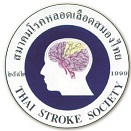A Study of Groin Access Site Complication and Affecting Factors in Acute Ischemic Stroke Patient Receiving Transfemoral Thrombectomy Treatment
Keywords:
Groin Access Site Complication, Thrombectomy, Acute Ischemic StrokeAbstract
Objective: This study was aimed at exploring groin access site complications and risk factors associated with femoral arterial punctures in post-mechanical thrombectomy patients with acute ischemic stroke conditions.
Methods: A retrospective chart review was conducted for all patients treated with mechanical thrombectomy in the Acute Stroke Unit at Ramathibodi Hospital from January 2017 until December 2021. Of these, 138 patients underwent femoral arterial insertion for mechanical thrombectomy. The sample was recruited according to specific criteria. Data was collected from recorded procedural documents and analyzed using descriptive statistics and logistic regression analysis.
Results: The study revealed that overall 11.59 percent of patients had groin access site complications. The most frequent complication of retained femoral arterial sheath was groin bleeding, occurring in 4.4 percent of cases. While after femoral arterial sheath removal, 2.17 percent of patients had complications of both hematoma and ecchymosis. The study found that patient factors and therapeutic factors were not associated with groin access site complications.
Conclusion: The incidence of groin access site complications in post-mechanical thrombectomy patients with acute ischemic stroke at Ramathibodi Hospital was found to be similar to previous studies. This study demonstrates no correlation between patient and treatment factors and access site complications due to limited sample size.
References
World Stroke Organization. Global Stroke Fact Sheet 2019 [Internet]. Canada: World Stroke Organization; 2019 [cited 2022 April 5]. Available from: https://www.worldstroke.org/assets/downloads/WSO_Fact-sheet_15.01.2020.pdf.
สุภโชค เวชภัณฑ์เภสัช. สถิติสาธารณสุข พ.ศ. 2563 [อินเทอร์เน็ต]. นนทบุรี: กองยุทธศาสตร์และแผนงานกระทรวงสาธารณสุข; 2564 [เข้าถึงเมื่อ 5 เม.ย. 2565]. เข้าถึงได้จาก https://bps.moph.go.th/new_bps/sites/default/files/2563_0.pdf
กิ่งแก้ว ปาจรีย์. ความรู้ทั่วไปเกี่ยวกับโรคหลอดเลือดสมอง.พิมพ์ครั้งที่ 1. กรุงเทพฯ:แอล.ที.เพลส; 2547.
พรภัทร ธรรมโสรช. โรคหลอดเลือดสมองตีบและอุดตัน. พิมพ์ครั้งที่ 1. กรุงเทพฯ:จรัลสนิทวงศ์การพิมพ์จำกัด; 2555.
Worakijthamrongchai T. Endovascular Treatment in Acute Ischemic Stroke. J Thai Stroke Soc 2017;16(3).
Hacke W, Kaste M, Bluhmki E, Brozman M, Dávalos A, Guidetti D, et al. Thrombolysis with alteplase 3 to 4.5 hours after acute ischemic stroke. N Engl J Med 2008;359(13).
Lees KR, Bluhmki E, von Kummer R, Brott TG, Toni D, Grotta JC, et al. Time to treatment with intravenous alteplase and outcome in stroke: an updated pooled analysis of ECASS, ATLANTIS, NINDS, and EPITHET trials. Lancet 2010;375(9727).
พรภัทร ธรรมสโรช, ดิษยา รัตนากร, สามารถ นิธินันทน์, ศิรินธรา สิงหรา ณ อยุธยา, อัญชลี ชูโรจน์, สุรีรัตน์ สุวัชรังกูรและคณะ. แนวทางการรักษาของประเทศไทยสำหรับผู้ป่วยโรคหลอดเลือดสมองขาดเลือดระยะเฉียบพลันโดยการรักษาผ่านสายสวนหลอดเลือดประเทศไทย. วารสารสมาคมโรคหลอดเลือดสมองไทย 2019;18(2)
Goyal M, Menon BK, Zwam WHV, Dippel DW, Mitchell PJ, Demchuk AM, et al. Endovascular thrombectomy after large-vessel ischaemic stroke: a meta-analysis of individual patient data from five randomised trials. Lancet 2016;387(10029).
Albers GW, Marks MP, Kemp S, Christensen S, Tsai JP, Ortega- Gutierrez S, et al. Thrombectomy for Stroke at 6 to 16 Hours with Selection by Perfusion Imaging. N Engl J Med 2018;378(8).
Nogueira RG, Jadhav AP, Haussen DC, Bonafe A, Budzik RF, Bhuva P, et al. Thrombectomy 6 to 24 Hours after Stroke with a Mismatch between Deficit and Infarct. N Engl J Med 2018;378(1).
สุรศักดิ์ โกมลจันทร์, ยอดขวัญ วัฒนะเสน, ศิริรัตน์ คุณวุฒิดี. Endovascular Treatment for Large Arterial Ischemic Stroke in Thailand at Present and Future. วารสารประสาทวิทยาแห่ประเทศไทย 2020;36(4).
Oneissi M, Sweid A, Tjoumakaris S, Hasan D, Gooch MR, Rosenwasser RH, et al. Access-Site Complications in Transfemoral Neuroendovascular Procedures: A Systematic Review of Incidence Rates and Management Strategies. Oper Neurosurg (Hagerstown) 2020;19(4).
Brenna CTA, Ku JC, Pasarikovski CR, Priola SM, Dyer EE, Howard P, et al. Access-site complications in ultrasound-guided
endovascular thrombectomy: a single-institution retrospective cohort study. Neurosurg Focus 2021;51(1).
Shapiro SZ, Sabacinski KA, Mantripragada K, Shah SS, Stein SS, Echeverry NB, et al. Access-Site Complications in Mechanical Thrombectomy for Acute Ischemic Stroke: A Review of Prospective Trials. AJNR Am J Neuroradiol 2020;41.
Shah VA, Martin CO, Hawkins AM, Holloway WE, Junna S, Akhtar N. Groin complications in endovascular mechanical thrombectomy for acute ischemic stroke: a 10-year single center experience. J NeuroIntervent Surg C 2016;8(6).
Simonetti BG, Hulliger J, Mathier E, Jung S, Fischer U, Sarikaya H, et al. Iatrogenic Vessel Dissection in Endovascular Treatment of Acute Ischemic Stroke. Clin Neuroradiol 2019;29(1).
สุภา จอมแจ้ง, รัชนี นามจันทรา. ปัจจัยที่สัมพันธ์กับการเกิดภาวะแทรกซ้อนทางหลอดเลือดในผู้ป่วยที่ได้รับการรักษาโรคหลอดเลือดโคโรนารีย์ผ่านสายสวนบริเวณขาหนีบ. สมาคมสถาบันอุดมศึกษาเอกชนแห่งประเทศไทย 2019;6(2).
Nantasukhon A, Siripittayakunkit A. A study of the patients’ vascular complications and pain after cardiac catheterization between transfemoral artery and transradial artery approach at post catheterization care unit, Ramathibodi hospital. Mahidol R2R e-Journal 2019;6(2).
Al-Momani MS, AbuRuz ME. Incidence and predictors of groin complications early after coronary artery intervention: a prospective observational study. BMC Nursing 2019;18:24.
Shiraishi J, Koshi N, Matsubara Y, Nishimura T, Ito Daisuke, Kimura M, et al. Effects of Baseline Thrombocytopenia on In-hospital Outcomes in Patients Undergoing Elective Percutaneous Coronary Intervention. Intern Med 2019;58(12).
Castillo-Sang M, Tsang AW, Almaroof B, Cireddu J, Sferra J, Zelenock GB, et al. Femoral artery complications after cardiac catheterization: a study of patient profile. Ann Vasc Surg 2010;24(3).
Stone PA, Campbell JE. Femoral pseudoaneurysms after percutaneous access. J Vasc Surg 2014;60(5).
Hendrix P, Collins MK, Goren O, Weiner GM, Dalal SS, Melamed I, et al. Femoral Access-Site Complications with Tenecteplase versus Alteplase before Mechanical Thrombectomy for Large-Vessel-Occlusion Stroke. AJNR Am J Neuroradiol 2023.
Das R, Ahmed K, Athanasiou T, Morgan RA, Belli AM. Arterial closure devices versus manual compression for femoral haemostasis in interventional radiological procedures: a systematic review and meta-analysis. Cardiovasc Intervent Radiol 2011;34.
Downloads
Published
How to Cite
Issue
Section
License
Copyright (c) 2023 Journal of Thai Stroke Society

This work is licensed under a Creative Commons Attribution-NonCommercial-NoDerivatives 4.0 International License.
ข้อความภายในบทความที่ตีพิมพ์ในวารสารสมาคมโรคหลอดเลือดสมองไทยเล่มนี้ ตลอดจนความรับผิดชอบด้านเนื้อหาและการตรวจร่างบทความเป็นของผู้นิพนธ์ ไม่เกี่ยวข้องกับกองบรรณาธิการแต่อย่างใด การนำเนื้อหา ข้อความหรือข้อคิดเห็นของบทความไปเผยแพร่ ต้องได้รับอนุญาตจากกองบรรณาธิการอย่างเป็นลายลักษณ์อักษร ผลงานที่ได้รับการตีพิมพ์ในวารสารเล่มนี้ถือเป็นลิขสิทธิ์ของวารสาร





